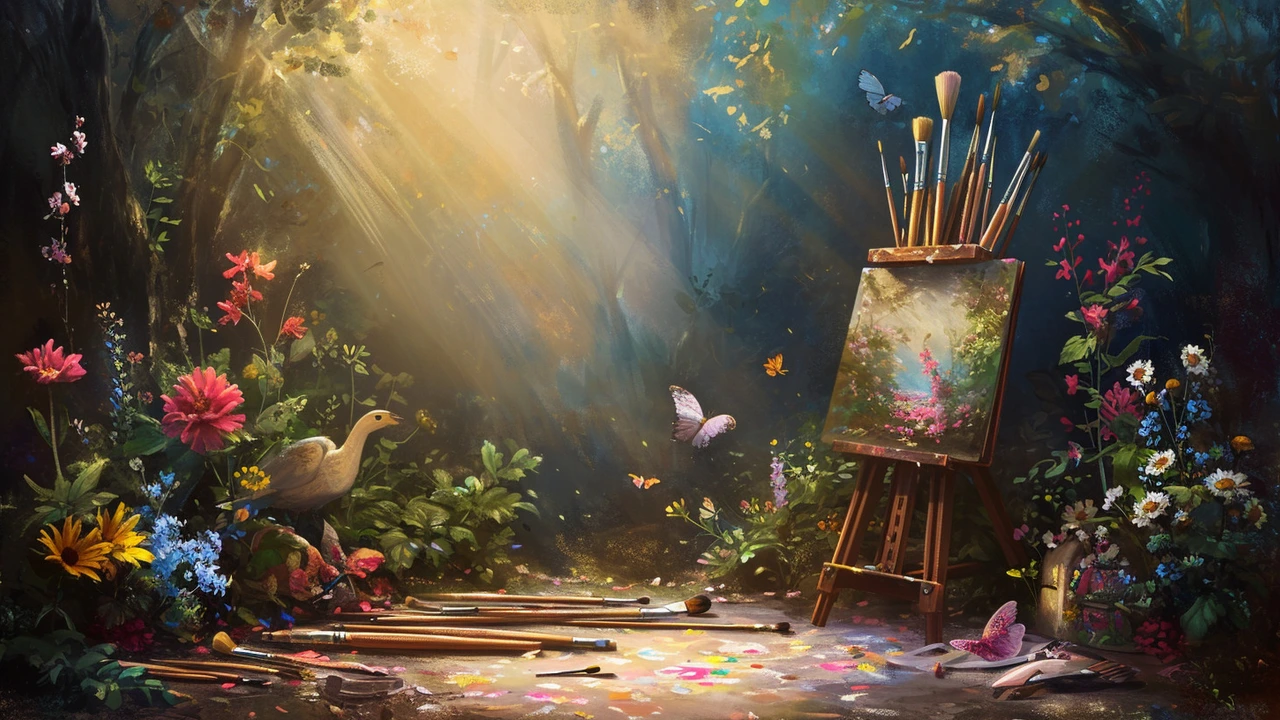Unveiling Creative Arts Therapies
When you hear the term "creative arts therapies," you might picture a cross between a kindergarten finger painting session and a New Age meditation class. As whimsical as that sounds, the reality is both more profound and significantly more powerful. So what exactly falls under this umbrella? Creative arts therapies encompass a group of therapeutic techniques that use art, music, drama, dance, or writing as their primary modes of communication and healing. It's not just about creating something pretty to hang on the fridge door—I'm talking about real, rigorous therapeutic practice aimed at improving mental, emotional, and even physical health. Now, that's not to say there's anything wrong with fridge art—it's just that when Millie, my tabby cat, tries to create art, it usually involves a chase scene that ends with shredded paper and a displeased cat.
Let me paint you a broader picture (pun intended). Imagine a setting where, instead of talking out your issues, you could draw them, dance them, or sing them. Doesn't that sound liberating? This is key, especially for those who find traditional verbal communication challenging. Whether it's because words can't capture the weight of trauma, or because someone is too young or too reserved to express their feelings, creative arts therapies offer an alternative language. It's more than just therapy—it's letting your inner self shine through the mediums that resonate most. It’s like when I tried explaining to Millie the importance of a vase; she simply stared, knocked it over, and proceeded to communicate her indifference through a nap. Clearly, her actions spoke volumes.
Art Therapy: More Than Just Doodles
Let's dive into the colorful world of art therapy first. Imagine you're faced with a blank canvas, and as you start to brush on the colors, your emotions flow right out of you with every stroke. Art therapy isn't about creating a masterpiece, but rather it’s about the process of pouring your soul onto a piece of paper and examining what comes out. Therapists are trained to help you interpret the forms and colors, offering insight into your subconscious mind. It's a bit like being a detective in a crime drama, except the mystery to be solved is your own psyche, and the dramatic chase scenes are replaced with contemplative brush strokes.
For instance, in art therapy, you might be asked to draw your 'safe place,' which sounds straightforward until you're staring down at a blank sheet and wondering whether 'safe place' means your bed or a tropical beach—that or the best spot on the couch where you can reach the TV remote without stretching too much. Believe it or not, these choices tell the therapist heaps about what makes you tick. And, the beauty of art therapy is that it's suitable for all; it's like a universal charger that fits into any socket of need, making it an accessible option for people of different ages, abilities, and backgrounds.
Dancing Away the Blues with Dance/Movement Therapy
Now, let's waltz over to dance/movement therapy. Imagine processing your feelings through movement. It might sound peculiar at first—who deals with their problems by pirouetting? Yet, it turns out the body can express things the mouth can't. By analyzing your movements, a dance therapist can unlock emotions you might not even realize are holding you sway. It's not about pulling off perfectly pointed toes; it's about letting your body speak when words fail. It's a holistic approach that understands that your emotional and psychological health is intertwined with your physical self.
Think of it this way—when you're angry, don't you feel better after stomping around a bit? Or when joy bubbles up inside you, doesn't a spontaneous little jig just happen? That’s the kind of emotional release dance/movement therapy taps into, but on a deeper therapeutic level. It can be an incredibly empowering experience to embody your feelings and let them out through motion, not to mention it can also be a fantastic workout. After all, even Millie understands the therapeutic power of movement; you should see her go in a full-on zoomies session around the house. It's a sight to behold, and while I wouldn't call it therapy, she certainly seems to work something out during those sprints!
The Healing Harmonies of Music Therapy
Strumming on the heartstrings, let's harmonize our understanding of music therapy. If you've ever created a playlist to nurse a broken heart or to pump yourself for an interview, you've scratched the surface of what music therapy can offer. Music therapists use tunes and melodies to reach emotional depths or cognitive pathways that might be fenced off or tough to navigate. You can engage in creating music, or simply be receptive to its effects, and either way, the transformative power of music can be staggering.
To give you a tune to think about, once I read about a man who barely spoke after being diagnosed with Alzheimer's. But when his music therapist played his favorite songs from when he was young, he began singing along! It was as if the music unlocked a door to his past and his identity that was thought lost. Imagine that, memories and connections, rekindled through melody and rhythm—it's downright electric! Oh, and there's no need to worry for those who are tone-deaf like me; the therapy is in the experience, not in hitting the right notes. It's a relief, really, because my singing could probably make my cat Millie pack her bags and leave.
Dramatherapy: Stepping onto the Stage of Healing
Now, if life is a stage, then dramatherapy is all about using that stage to script a better path to wellness. Here, patients use role-play, storytelling, and performance to unpack and work through their experiences. It's like getting to press 'pause' on the real world and step into a space where you can reframe and understand your roles and narratives. A dramatherapist guides you as you explore this theatrical journey—a journey that can lead to profound insights and emotional restoration.
For example, you could find yourself taking on the 'role' of someone you're at odds with. By walking a mile in their shoes, so to speak, you might discover empathy and a new perspective on a conflict with a loved one. And before you start thinking it’s all very 'Hollywood', remember this doesn't involve an Oscar-worthy performance (although feel free to give it your all if you wish!). It's about the therapeutic potential in the act of storytelling and playing parts we may not usually embody. It’s like when I catch Millie sitting on my laptop—she’s not just being a bother, she’s pursuing a career in writing, obviously! But in all seriousness, it does sometimes make me wonder if there’s a misunderstood Shakespearean actress behind those feline eyes.
Writing Therapy: Penning Down the Pain
Moving from the stage to the page, writing therapy is where you unpack your baggage using words as your tools. It might start with a journal, a poem, or even a letter you never send. Here, the act of writing can be cathartic; it offers a way to articulate and face your fears, joys, and deepest thoughts. It’s a private stage where the pen can capture what your voice might be too timid to say out loud. Think of it this way: every time you write, you’re engaging in a dialogue with your inner self.
It reminds me of the time I started a blog post about the importance of self-care and ended up with a multi-page revelation on how I manage stress. I had started with the intention of sharing practical tips, yet delved into a deeply personal narrative. It was unexpected but strangely healing. Writing therapy provides this space for self-reflection and expression, inviting you to weave your thoughts into coherent threads. And, unlike sharing out loud, writing allows you to reread and reflect, to literally see your thought patterns and stories laid out in front of you. It's not about penning the next bestseller; it's about the therapeutic journey that unfolds with every line you write. Plus, no one critiques your grammar—unless you have a cat like Millie, who seems to judge everything I do, including this very sentence.
The Integration of Creative Arts Therapies in Medical Settings
Now, let's look at how the creative arts therapies integrate into modern medical treatments. It's not just an 'add-on' or 'feel-good' option; it's becoming an evidence-based part of holistic healthcare practices. Hospitals, rehabilitation centers, and palliative care environments are recognizing the value of creative expression in patient care. It's about blending color, rhythm, story, and movement into the otherwise sterile hallways of medicine.
In these settings, creative arts therapists work alongside doctors, psychologists, and other healthcare professionals. They're not there to replace traditional medicine but to complement it. You might see an art therapist working with a child recovering from surgery, using drawings to help them process their experience. Or perhaps a music therapist playing gentle melodies for patients in a hospice, lifting spirits and easing pain without a single spoken word. It's about recognizing that healing is multi-layered, just like human beings. And while it might seem avant-garde to some, rest assured, it's based on rigorous training, clinical research, and clear therapeutic goals. Each brush stroke, dance move, musical note, and narrative arc is part of a strategic approach aimed at improving quality of life and health outcomes.
Creative Arts Therapies for Mental Health and Beyond
While the roots of creative arts therapies are often associated with mental health treatment, their branches stretch out across the full canopy of healthcare. From helping stroke survivors regain movement through dance therapy, to assisting people with autism to find new ways to communicate through art, the potential is vast. It's not just about emotional ailments; it’s about physical and neurological ones, too.
Take, for example, depression and anxiety, two all-too-common bedfellows in today's fast-paced world. Creative arts therapies offer a natural type of medicine—a canvas to color in your feelings or a drama exercise to act out your anxieties. It's a tactile, immediate form of therapeutic engagement that doesn't rely solely on medication or verbal therapy, although it can beautifully support both. What's more, with the expressive arts, there is a tangible outcome. It's one thing to talk about your feelings; it's another to literally see them, to have them witnessed and held in a song, a painting, or a performance. Just the other day, I found myself sketching what 'anxiety' felt like. It turned out to be a jumble of lines and stormy colors, a visual that spoke more to me than I had anticipated. It was a moment of clarity, made tangible through art. And while Millie's version of a stress-relief exercise involves knocking things off my desk, one can't help but admire her feline simplicity.
Emotional Literacy and Psychological Insight Through Creative Expression
Developing emotional literacy is another superb benefit of engaging with creative arts therapies. Just like learning to read or write, understanding and expressing our emotions can be learned and refined. Through the arts, we can become fluent in the language of our inner worlds. It's not just about feeling better; it's about understanding why we feel certain ways and how we can articulate and manage those feelings moving forward.
By tapping into creative expression, we also gain psychological insight. It's like turning on a light in a previously dim room in your mind. Suddenly, you see the corners and contours of your emotions and thoughts. It's a bit of an adventure, if I'm honest—like exploring a cave with a trusty lantern (just make sure to keep Millie away from the cave, lest she sees her shadow and scampers off into the dark, ignoring all calls for a sensible return).
Conclusion: The Infinite Canvas of Human Healing
In wrapping up this exploration into the intertwined relationship between creative arts therapies and medicine, it's pretty clear that human healing is like an infinite canvas, offering endless possibilities for recovery, understanding, and growth. In modern medicine, where we often focus on the physical, there is a beautiful renaissance happening—a reinvigoration of the understanding that care of the mind and soul is as crucial as that of the body.
The creative arts therapies are part of this holistic approach, painting a fuller picture of health that includes emotional hues and psychological contours. So whether you are navigating a tough chapter in life, facing a chronic illness, or simply seeking deeper self-understanding, consider the power of the arts. It's not just about the final product—it's about the transformative journey, the therapeutic process, and the stories we tell along the way.
And now, if you’ll excuse me, I'm off to try some art therapy of my own. Just need to make sure Millie hasn't turned my art supplies into her latest toy. Ah, the joys of pet ownership and the unexplored therapeutic benefits of cat-chasing! Wishing you all a journey of healing filled with your own unique blend of creative expression—may it be as colorful, vibrant, and as meaningful as you are. Until the next burst of inspiration strikes, keep exploring the myriad of ways to express, let go, and dance through the melody of life's challenges and joys.






